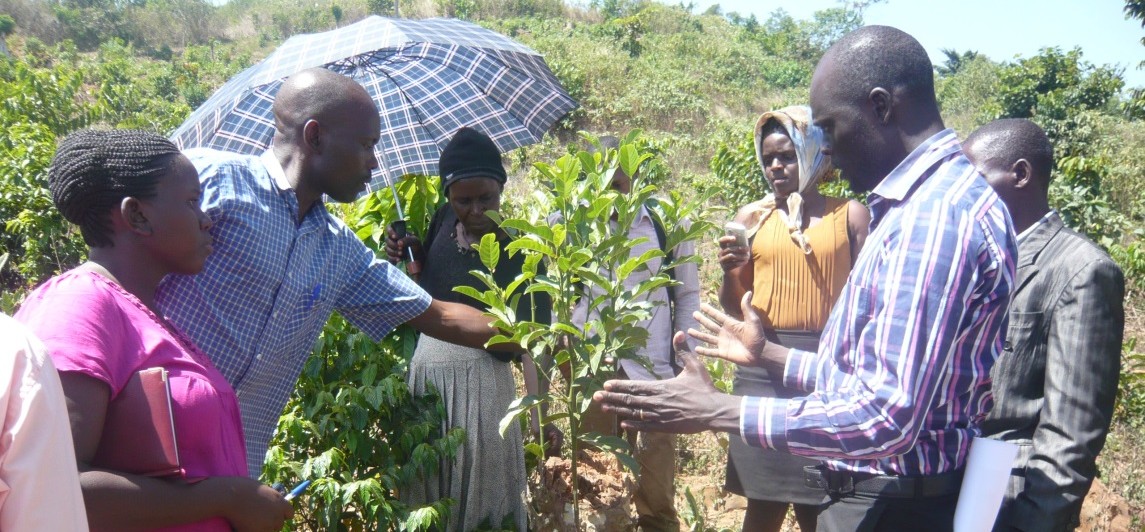
FMNR Network in Uganda – the power of working collaboratively
January 20, 2016
In Uganda the Farmer Managed Natural Regeneration for East Africa Project, funded by World Vision Australia and the Australian government, has been going since 2012 and has seen some incredible gains in the national adoption of FMNR. One of the greatest successes has been the development of a national Farmer Managed Natural Regeneration Network. This network was born from an FMNR Conference which was put on by World Vision Uganda in 2014 and attended by many organisations in the country who were working in the development and/or environmental space. The reactions from this conference was so positive that a group of organisations voluntarily came together to form an official network to work collaboratively to both practice FMNR and advocate for its inclusion in other organisations. This group currently consists of nine different Ugandan organisations.
Here are the journeys of two organisations now actively involved in this network:
Vi Agroforestry
 Vi is a non-Governmental organization working in Uganda to restore Environmental and Sustainable Agricultural Productivity in the communities. Before Vi knew about FMNR model, they used to buy and plant tree seedlings in an effort to increase forest cover. In July 2014 at the national FMNR conference organized by World Vision Uganda, Vi Agroforestry learnt about FMNR model and its benefits. The organization wanted to be sure that the model works before they could integrate it into their programs. They tried out a pilot demonstration garden in Mpigi district. This was successful and the model was rolled out to their implementing partners. They also carried out a research to find out survival rates of indigenous tree species as compared to non-indigenous trees and found out that survival of indigenous species was 70%. Since December 2014, 6 partner organizations have been trained in FMNR. Vi allocated a staff and a budget for implementation of FMNR activities. Further still, a monitoring tool has been developed to track progress of the work. Vi intends to market the model to its partners as a way of scaling up FMNR. The organization has collaborative relationship with up to 60,000 farmer groups. FMNR has a high potential for increasing tree cover in Uganda.
Vi is a non-Governmental organization working in Uganda to restore Environmental and Sustainable Agricultural Productivity in the communities. Before Vi knew about FMNR model, they used to buy and plant tree seedlings in an effort to increase forest cover. In July 2014 at the national FMNR conference organized by World Vision Uganda, Vi Agroforestry learnt about FMNR model and its benefits. The organization wanted to be sure that the model works before they could integrate it into their programs. They tried out a pilot demonstration garden in Mpigi district. This was successful and the model was rolled out to their implementing partners. They also carried out a research to find out survival rates of indigenous tree species as compared to non-indigenous trees and found out that survival of indigenous species was 70%. Since December 2014, 6 partner organizations have been trained in FMNR. Vi allocated a staff and a budget for implementation of FMNR activities. Further still, a monitoring tool has been developed to track progress of the work. Vi intends to market the model to its partners as a way of scaling up FMNR. The organization has collaborative relationship with up to 60,000 farmer groups. FMNR has a high potential for increasing tree cover in Uganda.
The Hunger Project Uganda
 The Hunger Project Uganda (THPU) is an NGO and a member of FMNR Network. The organization has been very keen on implementing FMNR model. To increase their knowledge of FMNR, they requested for training of their staff and it was conducted in one of their regional epi-centers. The trained staff have sensitised the community about using FMNR. Another staff member from the THPU was trained at a Training of Trainers (TOT) organised by WVU. This staff member has in turn trained other staff as well community volunteers. THPU was invited by USAID to make a presentation on climate smart agriculture and the Head of Programs, Dorothy Nabwire, decided to made a presentation on FMNR as an appropriate model for climate smart agriculture. The presentation on FMNR was so successful that one of the partners attending the meeting invited THPU to train their farmers on FMNR for two weeks. This training was made possible by materials provided by Cotilda Nakyeyune, the FMNR Project Coordinator at World Vision Uganda. Four staff, and the farmers they work with, were trained. Dorothy felt that not enough people currently knew about FMNR and there is a need for increased awareness about the model.
The Hunger Project Uganda (THPU) is an NGO and a member of FMNR Network. The organization has been very keen on implementing FMNR model. To increase their knowledge of FMNR, they requested for training of their staff and it was conducted in one of their regional epi-centers. The trained staff have sensitised the community about using FMNR. Another staff member from the THPU was trained at a Training of Trainers (TOT) organised by WVU. This staff member has in turn trained other staff as well community volunteers. THPU was invited by USAID to make a presentation on climate smart agriculture and the Head of Programs, Dorothy Nabwire, decided to made a presentation on FMNR as an appropriate model for climate smart agriculture. The presentation on FMNR was so successful that one of the partners attending the meeting invited THPU to train their farmers on FMNR for two weeks. This training was made possible by materials provided by Cotilda Nakyeyune, the FMNR Project Coordinator at World Vision Uganda. Four staff, and the farmers they work with, were trained. Dorothy felt that not enough people currently knew about FMNR and there is a need for increased awareness about the model.
